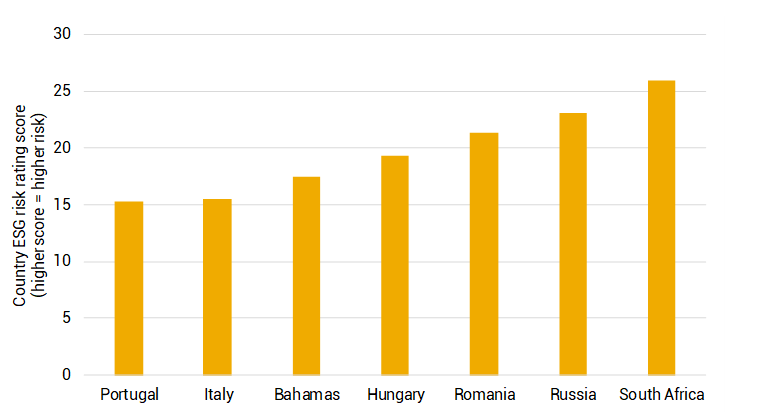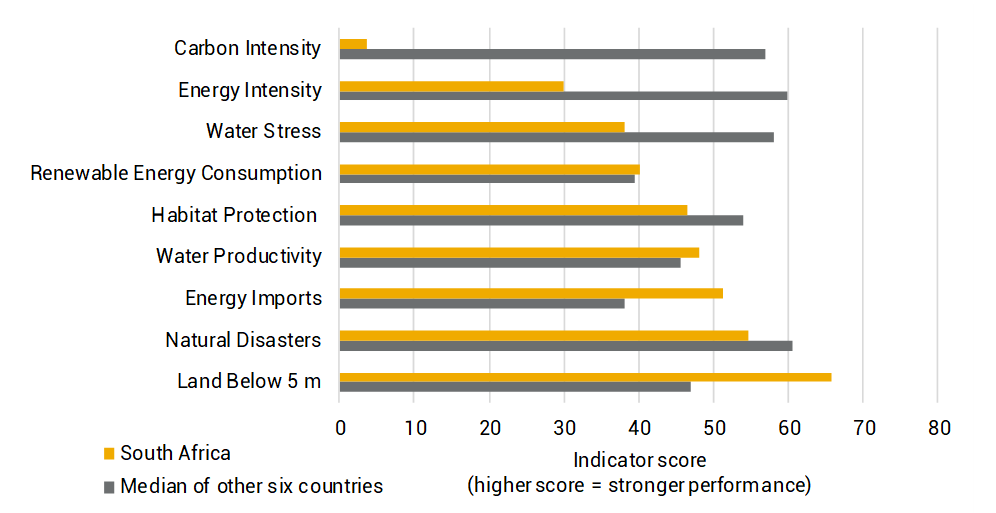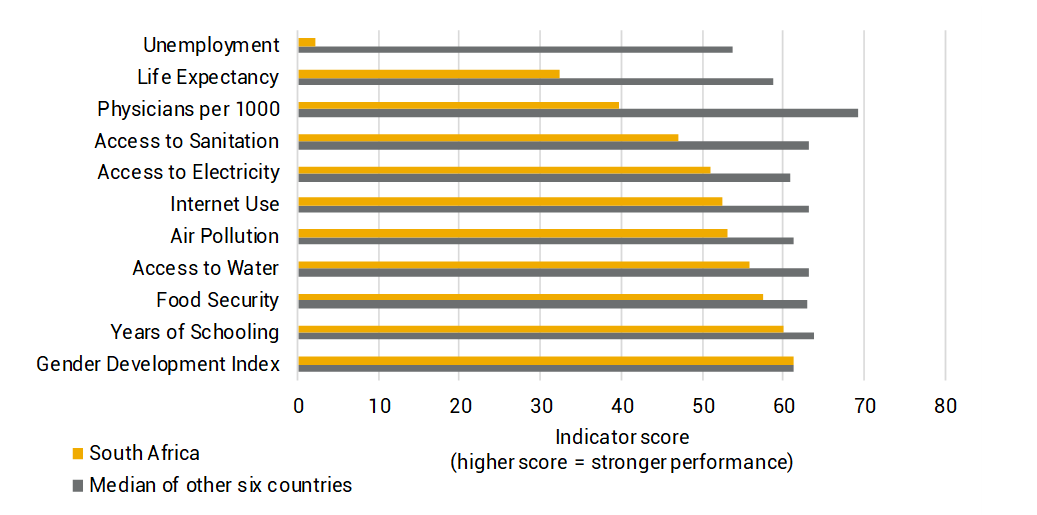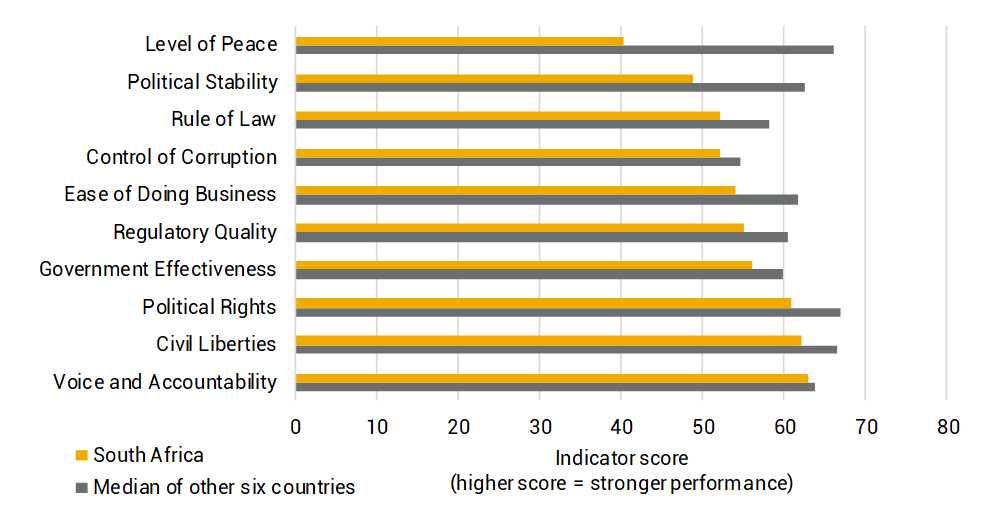A Case Study
On November 1, 2019 Moody’s cut its rating outlook for South Africa from “Baa3 stable” to “Baa3 negative,” putting the country’s bonds on the cusp of junk status after several harbingers of a potential downgrade.[i] Earlier this year, the World Bank and the International Monetary Fund cut their 2019 growth forecasts for South Africa to around 0.8%, while the Institute of International Finance warned that the country’s public debt could grow to 95% of Gross Domestic Product (GDP) by 2024.[ii] The other two big credit rating agencies (CRAs) – Fitch and S&P – downgraded South Africa’s credit rating to sub-investment grade back in 2017, citing a deterioration in the country’s public finances.[iii]
In this post, we present a framework for assessing environmental, social and governance (ESG) risk in South Africa by comparing the country’s ESG risk profile to those of six other countries that, like South Africa, are rated by Moody’s as Baa3.[iv] Our analysis identifies key sources of risk for bond investors to consider prioritizing in their monitoring of South Africa, including climate change, unemployment and political stability.
As discussed in our recently published ESG Spotlight report, New Frontiers: African Sovereign Debt and ESG Risk, a range of ESG issues, from natural resource management to public health and business ethics, can affect sovereign credit because how a country manages such factors can influence its revenues, foreign investments, the likelihood of it defaulting on its debt payments and the volatility in the price of its bonds.[v] Our study found that sovereign credit ratings and ESG risk ratings exhibit a strong positive correlation (coefficient=0.83), which may be in part due to CRAs’ incorporating many governance issues into their assessments. However, this post reveals how countries with comparable credit ratings can present substantially different levels of ESG risk.
Comparing South Africa to other Baa3-rated countries
As shown in Exhibit 1, South Africa’s overall ESG Risk Rating is higher (i.e. it is at higher risk) than that of six other countries that Moody’s rates as Baa3, including Portugal, Italy, the Bahamas, Hungary, Romania and Russia. To better understand the sources of ESG risk in South Africa, we take a closer look at how the country performs relative to other Baa3-rated countries on management indicators that feed into the three main dimensions of our model – (1) natural and produced capital, (2) human capital and (3) institutional capital.
Exhibit 1: Sustainalytics Country Risk Ratings of seven Baa3-rated countries

Dimension 1: Natural and produced capital
South Africa underperforms our sample median on five of the nine indicators of natural and produced capital listed in Exhibit 2, including carbon intensity, energy intensity, water stress, habitat protection and natural disasters. As South Africa’s energy and water intensive industries, such as mining and agriculture, are particularly exposed to climate risks, we anticipate carbon, energy and water issues to play an increasingly important role in assessing the country’s creditworthiness.
Exhibit 2: Key measures of natural capital: South Africa vs median scores of six other Baa3-rated countries*

Much of South Africa’s climate risk stems from the country’s reliance on fossil fuels, especially coal. Although South Africa has set targets to increase renewable energy use to 33% of the energy mix by 2030, to date, coal accounts for 80% of the country’s energy output, and it remains among the top 20 emitters of carbon globally.[vi] In our model, South Africa’s natural wealth is highly discounted to account for transition risks associated with its coal reserves.
Transition risks aside, South Africa also faces physical climate risks, as its climate is semi-arid and its freshwater resources are spread scarcely and unevenly around the country.[vii] Indeed, upwards of 30% of the country’s agricultural production relies on irrigation.[viii] Water use has been a policy concern for South Africa’s municipalities since the 2015 drought, during which Cape Town nearly ran out of water.[ix]
Dimension 2: Human capital
South Africa’s per capita human capital wealth is among the highest in Africa. However, the country is lagging in its management of pressing human capital risks. As shown in Exhibit 3, South Africa is behind the median of other Baa3-rated countries on 10 of 11 indicators of human capital, with the largest gaps in its performance centering on issues related to employment and health.
Exhibit 3: Key measures of human capital: South Africa vs median scores of six other Baa3-rated countries*

Although South Africa has historically had strong health and education infrastructure, its employment rate and public health system have struggled in recent years and accessing these institutions has been especially challenging for poor South Africans. A major problem for the health system is a lack of medical personnel in public healthcare facilities; South Africa’s doctor to patient ratio is 0.9 per 1000 people. In a bid to improve the health system, the government announced plans to implement universal national health insurance by 2026.[x] But considering its current fiscal challenges, this timeline may not be realistic.
Subdued economic growth since the 2015 commodity price slump has led to job cuts across multiple sectors, driving high unemployment rates. As of Q2 2019, the jobless rate reached 29%, with over half of youth unemployed.[xi]
Dimension 3: Institutional capital
Finally, we look at South Africa’s performance on measures of institutional capital. Exhibit 4 reveals that South Africa trails the median rating of the six other Baa3-rated countries on all 10 of the instiutional capital indicators that feed into our model.
Exhibit 4: Key measures of institutional capital: South Africa vs median scores of six other Baa3-rated countries*

Since the end of apartheid, South Africa has worked to improve conditions related to civil liberities, political rights and state institutions. However, recent incidents of alleged corruption among high ranking political officers, which led to the resignation of former President Zuma, have undermined trust in the government.[xii] Moreover, South Africa’s level of peace has been shaken by recent xenophobic attacks on migrants.[xiii] These and other political issues threaten stability in the region, which is a growing concern for investors.
Another major concern related to institutional capital is the fate of Eskom, a state-run utility that has become reliant on government bailouts to remain solvent. Since Eskom supplies 95% of South Africa’s power, the country’s energy intensive industries, such as mining and manufacturing, depend on the firm’s continued operations. According to Sustainalytics’ corporate ESG Risk Ratings, Eskom is rated as severe ESG risk, and its track record includes significant governance and business ethics controversies. Eskom’s management difficulties pose further risks to the country’s ability to meet its energy transitions goals.
Conclusion – ESG assessment, further research and applications
Our assessment of South Africa is that the country is struggling to address a wide range of ESG issues. While the country has potential to mitigate some risks by doubling down on its relative strengths, such as renewable energy use, many pressing issues, including climate change, unemployment and corruption present major obstacles to growth.
South Africa is behind other Baa3-rated countries on most of the ESG performance indicators that contribute to our Country Risk Ratings, but other factors may also help investors develop a more a holistic assessment of a government’s creditworthiness. Additional criteria that determine Sustainalytics’ Country Risk Ratings include each country’s wealth (adjusted for stranded asset risk), its momentum on ESG issues, and events.
Investors can build on the framework presented here by integrating these and other data points into their portfolio strategies by, for example, customizing the weights of their bond holdings to reflect varying levels of ESG risks. Some investors have also had success with engaging governments on key ESG issues to better understand whether emerging policies and programs can sufficiently mitigate material risks.[xiv]
To learn more about Sustainalytics’ Country Risk Ratings and how South Africa compares to other African countries, download our report, New Frontiers: African Sovereign Debt and ESG Risk.
Endnotes
[i] Cotterill, J. (01.11.2019) “S Africa debt risks junk status after Moody’s cuts outlook,” Financial Times, accessed (01.11.2019) at: https://www.ft.com/content/6f12864e-fcf8-11e9-a354-36acbbb0d9b6.
[ii] Dludla, S. (16.10.2019), “IMF lowers South Africa’s growth forecast for 2019 to a paltry 0.7%,” IOL Business Report, accessed (29.10.2019) at: https://www.iol.co.za/business-report/economy/imf-lowers-south-africas-growth-forecast-for-2019-to-a-paltry-07-35035841.
[iii] Kumwenda-Mtambo, O. and Toyana, M. (24.11.2017), Reuters, “S&P downgrades South Africa’s local currency debt to ‘junk’ status,” Reuters, accessed (29.10.2019) at: https://www.reuters.com/article/us-safrica-ratings/sp-downgrades-south-africas-local-currency-debt-to-junk-status-idUSKBN1DO2MY;
[iv] Moody’s outlook on these countries varies, from negative to stable or positive.
[v] UN Principles for Responsible Investing (30.01.2019), ESG, Credit Risk and Ratings: Part 3 – From Disconnects to Action Areas, accessed (29.10.2019) at: https://www.unpri.org/credit-ratings/esg-credit-risk-and-ratings-part-3-from-disconnects-to-action-areas-/3996.article.
[vi] Winning, A. (18.10.2019), “South African power generation plan keeps coal in the mix,” Reuters, accessed (29.10.2019) at: https://www.reuters.com/article/us-safrica-energy/south-african-power-generation-plan-keeps-coal-in-the-mix-idUSKBN1WX0OD.
[vii] For an assessment of physical climate risks, including water stress, facing global equities, see: Vezér, M, Apostol, A. and Morrow, D. (2019), Hot Assets: Global Equities and Physical Climate Risk, Sustainalytics Spotlight Series Report, accessed (29.10.2019) at: https://www.sustainalytics.com/esg-research/issue-spotlights/global-equities-and-physical-climate-risk/.
[viii] The Water Wheel (2018), An Earth Observation Approach towards Mapping Irrigated Areas and Quantifying Water Use by Irrigated Crops in South Africa, (WRC Report No. TT 745/17), accessed (29.10.2019) at: http://www.wrc.org.za/wp-content/uploads/mdocs/WW%20July_Aug%202018%20IRRIGATION%20WATER%20USE.pdf.
[ix] Edmond, C. (23.08.2019), “Cape Town almost ran out of water. Here’s how it averted the crisis,” accessed (29.10.2019) at: https://www.weforum.org/agenda/2019/08/cape-town-was-90-days-away-from-running-out-of-water-heres-how-it-averted-the-crisis/.
[x] Cohen, M. (14.08.2019), “How South Africa plans to fix an ailing health system,” The Washington Post, accessed (29.10.2019) at: https://www.washingtonpost.com/business/how-south-africa-plans-to-fix-an-ailing-health-system/2019/08/14/7a8b0fae-be6a-11e9-a8b0-7ed8a0d5dc5d_story.html.
[xi] Toyana, M. (30.07.2019), “South African unemployment hits 11-year high,” Reuters, accessed (29.10.2019) at: https://af.reuters.com/article/idAFKCN1UP0YL-OZATP.
[xii] Bruce, P. (26.06.2019), “South African advisers rebuild trust after Zuma-era corruption,” Financial Times, , accessed (29.10.2019) at: https://www.ft.com/content/b1cb6ba2-86c6-11e9-b861-54ee436f9768.
[xiii] The Economist, “Hate thy neighbour,” accessed (29.10.2019) at: https://www.economist.com/middle-east-and-africa/2019/09/14/xenophobic-violence-flares-in-south-africa.
[xiv] Rahman, L. (07.08.2018), “ESG Integration and Engagement: South Africa Sovereign Credit” , PIMCO Blog, accessed (20.11.2019) at: https://blog.pimco.com/en/2018/08/esg-integration-and-engagement-south-africa-sovereign-credit.
Recent Content
Six Best Practices Followed by Industries Leading the Low Carbon Transition
In this article, we take a closer look at the leading industries under the Morningstar Sustainalytics Low Carbon Transition Rating (LCTR) and examine the best practices that have allowed them to emerge as leaders in managing their climate risk.
Navigating the EU Regulation on Deforestation-Free Products: 5 Key EUDR Questions Answered About Company Readiness and Investor Risk
The EUDR comes into effect in December 2024, marking an important step in tackling deforestation. In this article, we answer five key questions who the EUDR applies to, how companies are meeting the requirements, and the risks non-compliance poses to both companies and investors





-5-key-questions-answered-about-company-readiness-and-investor-risk.tmb-thumbnl_rc.jpg?Culture=en&sfvrsn=ee2857a6_2)